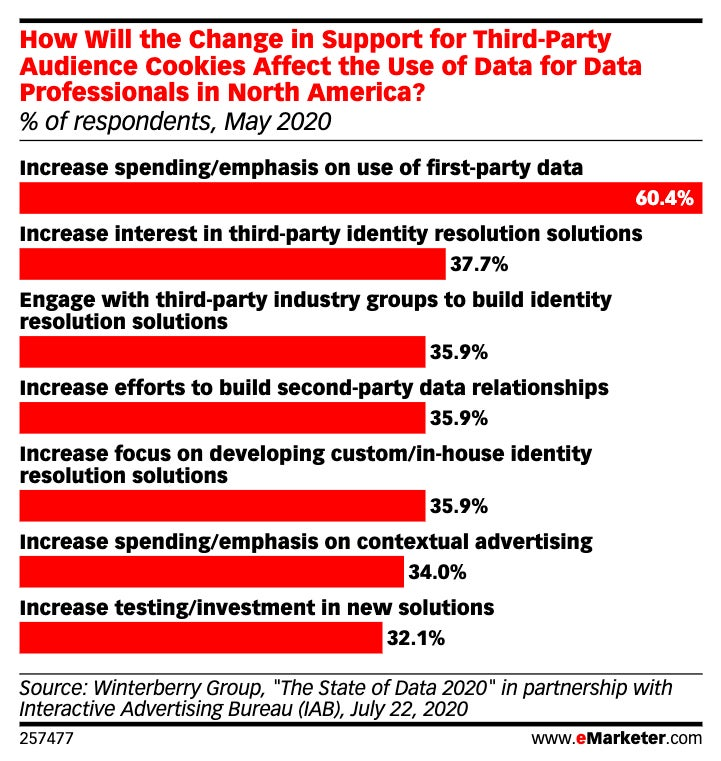3 marketing predictions for a cookieless world

Third-party cookies are on the chopping block, bringing with it several implications for the marketing industry and digital experience as a whole.
But first, let’s talk about what cookies are, and why organizations such as Apple, Google and Mozilla are doing away with them. Cookies first got a bad rap when third-party cookies — those used by a domain and usually a company not associated with a particular site that is being browsed — started to track user behavior across websites. This was incredibly useful for measuring the impact of an “impression.” But for many consumers it felt intrusive when the item that they looked at online began following them across the web. Globally, eMarketer estimates that about 82 percent of web ads rely on cookies and over 77 percent of websites globally have at least one or more tracking cookies.
But the truth is that third-party cookies were never all that great at driving accurate targeting or measurement for marketers. In fact, according to comScore, 55 percent of cookie-based measurement is overstated, and 35 percent of cookie-based demographic targeting is inaccurate. This data shows that third-party cookies are inefficient — they do not appear to be helping brands succeed in providing personalized experiences, nor do they give a unified view of customer activity.
In light of this, research from Winterberry Group and IAB forecasts increased spending and emphasis on first-party data and a move away from third-party cookies, which we have seen come to fruition in the last few years. We can also expect a heightened importance around identity resolution and consent, among other shifts in priorities for companies.

In a cookieless future, we will also see more informed and privacy conscious consumers, who are looking for brands to be transparent in how they are using their customers’ information. Below, we take a look at three shifts we can expect to see from brands in 2021 and beyond, as they attempt to stay relevant in a world without third-party cookies.
1. There will be a greater emphasis from brands on building consumer trust
While there may have been a time early on when data and privacy were not top of mind for consumers, that is not the case today. People are more knowledgeable when it comes to the information they are sharing across the web, and with whom. That is why it is important for brands to be transparent about their consumer data practices in clear, concise and straightforward language. Apple is already starting, with an ad that speaks to how the iPhone protects its owner’s privacy.
The increased focus on trust will also mean data governance will become a strategic priority within organizations. Expect more data steward-like roles to crop up within companies. Data stewards will need a combination of IT, compliance, privacy and legal skills, and will be responsible for building out policies for data governance and data usage. Enterprises will also be looking for vendors that have out-of-the-box data governance capabilities and privacy built into their solutions.
2. First-party data and identity will take on heightened importance
Marketers have been struggling with identity since the dawn of the web. And it is not getting any easier, now that Google, Apple and Mozilla have all decided to block third-party cookies.
“Users are demanding greater privacy — including transparency, choice and control over how their data is used — and it is clear the web ecosystem needs to evolve to meet these increasing demands,” Google wrote in an announcement on its blog.
We will see that companies that have already put a focus on consumer trust when building digital experiences and have restructured using first-party data strategies — from data collection to analysis and activations — will win in the long run.
We also expect a greater focus on making the right business alliances or data partnerships both internally and externally. Companies across industries will partner up to share audiences with explicit permission from their customers. The next trend: companies working closely together, brand to brand, to exchange resolved first-party audiences (with consumer consent, of course) in a secure, neutral environment.
Second-party data can be critical, especially when layered on top of a company’s first-party data. As Gary Walter, president and CEO of Infutor Data Solutions says in an article he penned for Adage, “Second-party data can offer brands access to a partner’s first-party data, so the marketer has the ability to hone in on relevant attributes and customize segmentation to build lookalike personas. These consumers are generally more relevant to the brand’s core offerings and closer to the source than third-party data, giving marketers a greater ability to connect and create more meaningful one-to-one engagements.”
3. Real-time personalization will be king
We expect there to be a renaissance in delivering highly relevant and personalized experiences in real-time, as companies look to thrive in a cookieless world.
Real-time personalization is not a new idea in marketing by any means, as marketers have deployed an array of data management tools and technologies over the years to cultivate it. A basic example of real-time personalization for a telco company: showing a customer the Android phone and accessories on your website’s homepage, since the person clicked on your Android ad yesterday on Facebook.
The ultimate goal: Delivering customer experiences that respond intelligently between every click, are respectful of consumer preferences, and represent the perfect response for recommendations or offers. But it’s been challenging for brands to find the right technology to power agility, intelligence and scale all at once. With third-party cookies, marketers had a “good enough” solution until now, but the industry shift is leading toward something much better.
The time is now to achieve true real-time personalization. The deduction of third-party cookies mean brands can no longer rely on pre-categorizing prospects based on interests attached to cookies. Instead, brands that do the hard work to bring their data and intelligence to meet the new customer moment will be rewarded in greater brand loyalty from a rich pool of delighted customers.
Closing thoughts
A heightened focus on trust, transparency and ethical data usage is going to be what separates the digital experience leaders from the laggards in 2021. Companies that have not already, must figure out how they are going to be more transparent in their use of customer data, what their data governance strategy and operation looks like, and the ways in which they will rely on contextual signals, align with consumer preferences, and first-party data. Brands should also be exploring options for second-party data partnerships. Relevancy is going to be key in 2021 and beyond. And while a third-party cookieless world does have major implications for companies, we believe it will be a service to consumers, and an opportunity for organizations to get closer to their customers than they ever have before.